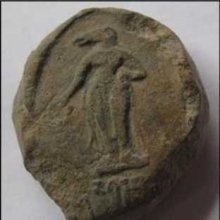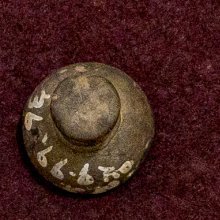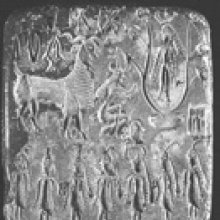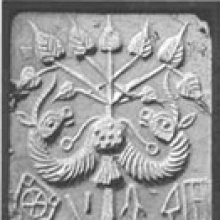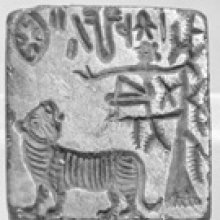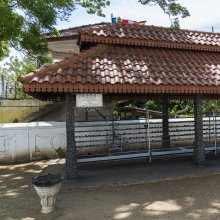Seal, Sealing, Sealed: 2 definitions
Introduction:
Seal means something in Hinduism, Sanskrit. If you want to know the exact meaning, history, etymology or English translation of this term then check out the descriptions on this page. Add your comment or reference to a book if you want to contribute to this summary article.
Images (photo gallery)
(+1 more images available)
In Hinduism
Natyashastra (theatrics and dramaturgy)
Source: Shodhganga: Elements of Art and Architecture in the Trtiyakhanda of the Visnudharmottarapurana (natya)(The holding of a) Seal or a Signet is associated with Mukula-hasta: one of the twenty-two Single-hand Gestures (in Indian Dramas) (known as asaṃyuktahastas), according to the Viṣṇudharmottarapurāṇa, an ancient Sanskrit text which (being encyclopedic in nature) deals with a variety of cultural topics such as arts, architecture, music, grammar and astronomy.—The Viṣṇudharmottarapurāṇa suggests that the tips of all fingers of the hand should be joined together to make this posture. When the tips of all fingers are joined together, it makes a shape of a blooming bud. [...] In the Abhinayadarpaṇa, the mukula-hasta posture is suggested to be used to denote flowers like water lily and the flower of kadalī i.e., banana. It says that, the holding of five arrows by Kāmadeva and a signet or a seal are also identified through this hand posture. The action of eating is also shown with this hand posture.

Natyashastra (नाट्यशास्त्र, nāṭyaśāstra) refers to both the ancient Indian tradition (shastra) of performing arts, (natya—theatrics, drama, dance, music), as well as the name of a Sanskrit work dealing with these subjects. It also teaches the rules for composing Dramatic plays (nataka), construction and performance of Theater, and Poetic works (kavya).
Yoga (school of philosophy)
Source: ORA: Amanaska (king of all yogas): A Critical Edition and Annotated Translation by Jason BirchSealing (a particular cavity) with a Yogic Mudrā is denoted by the Sanskrit term Mudrita, according to the Haṭhapradīpikā 4.100 (Cf. Uttaragīta 41cd-42, Maṇḍalabrāhmaṇopaniṣat 2.5.4-5, Gheraṇḍasaṃhitā 5.82-83ab).—Accordingly, “Because the [nasopharyngeal] cavity above the uvula has been sealed (mudrita) by Khecarī Mudrā, the [Yogin’s] semen is not emitted [even when he] has been embraced by a beautiful woman. So long as his semen remains in his body, then why [would there be] fear of death?”.

Yoga is originally considered a branch of Hindu philosophy (astika), but both ancient and modern Yoga combine the physical, mental and spiritual. Yoga teaches various physical techniques also known as āsanas (postures), used for various purposes (eg., meditation, contemplation, relaxation).
See also (Relevant definitions)
Starts with: Sealai, Sealimar, Sealingwax tree, Sealnegri.
Ends with: Thousand-seal.
Full-text (+819): Mudrita, Mudra, Mudrika, Mudrana, Samudra, Angulimudra, Mudrankita, Moharabanda, Dharmamudra, Mudranka, Lanchati, Pratimudra, Sarpamudraka, Mudramudrita, Shikkenisa, Seel, Muhar, Cunakkumuttirai, Maudrika, Upanidhi.
Relevant text
Search found 162 books and stories containing Seal, Sealing, Sealed; (plurals include: Seals, Sealings, Sealeds). You can also click to the full overview containing English textual excerpts. Below are direct links for the most relevant articles:
Guhyagarbha Tantra (with Commentary) (by Gyurme Dorje)
Text 22.5 (Commentary) < [Chapter 22 (Text And Commentary)]
Text 8.2 (Commentary) < [Chapter 8 (text and commentary)]
Text 12.3 (Commentary) < [Chapter 12 (Text and Commentary)]
Manusmriti with the Commentary of Medhatithi (by Ganganatha Jha)
Verse 8.180 < [Section XXXII - Deposits (nikṣepa)]
Verse 8.149 < [Section XXVI - Pledges (ādhi)]
Verse 8.188 < [Section XXXII - Deposits (nikṣepa)]
Settlement in Early Historic Ganga Plain (by Chirantani Das)
Part 10 - Cultural periods of Vārāṇasī < [Chapter VI - Vārāṇasī: Emergence of the Urban Centre and Seat of Administration]
Part 7 - Nalanda’s Rise of a Multi-functional Nodal Centre < [Chapter III - Nālandā: Evidence for rise and progress of the settlement]
Part 8 - Trade network of the Vārāṇasī region < [Chapter VI - Vārāṇasī: Emergence of the Urban Centre and Seat of Administration]
A Historical Study of Kaushambi (by Nirja Sharma)
Religion and Society of Kaushambi < [Chapter 1]
Historical Background of Kaushambi < [Chapter 2]
Kaushambi under the Maghas < [Chapter 2]
Amaravati Art in the Context of Andhra Archaeology (by Sreyashi Ray chowdhuri)
Lower Kṛṣṇā Valley (13): Sankaram < [Chapter 2 - Amarāvatī and other Archaeological Sites of Ancient Andhra Pradesh]
Lower Kṛṣṇā Valley (12): Rāmatīrtham < [Chapter 2 - Amarāvatī and other Archaeological Sites of Ancient Andhra Pradesh]
The flourishing agriculture and prosperity in Amarāvatī (Dhānyakaṭaka) < [Chapter 4 - Survival of Amarāvatī in the Context of Andhra Art]
Dasarupaka (critical study) (by Anuru Ranjan Mishra)
Part 2 - Summary of the drama (Mudrārākṣasa) < [Chapter 1 - Nāṭaka (critical study)]
Part 13 - Technical Aspects of a Nāṭaka < [Chapter 1 - Nāṭaka (critical study)]
Related products
(+23 more products available)
